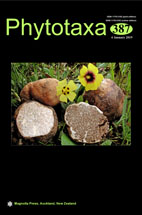Abstract
A new orchid species, Cymbidium yunnanensis (Orchidaceae; Epidendroideae; Cymbidieae), from Yunnan Province, China, is described and illustrated. Based on morphological and molecular analyses, we demonstrate that this new species is similar to C. floribundum, but it differs in its smaller size, leaves 5–15 cm, shorter scape, white flowers with pale purplish markings on its sepals and petals, lip with purplish red blotch, petals narrowly falcate oblong and lip midlobe nearly round with column foot 1.5–2.0 mm long. Phylogenetic analyses based on nuclear ribosomal ITS and plastid (matK, rbcL) DNA sequence data support C. yunnanensis as a new species.

